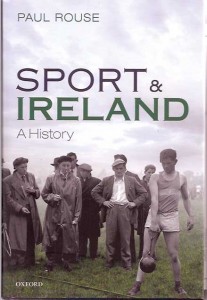SPORT AND IRELAND: A HISTORY
Published in Book Reviews, Issue 1 (January/February 2016), Reviews, Volume 24PAUL ROUSE
Oxford University Press
£30
ISBN 9780198745907
Reviewed by Kevin McCarthy

Firstly, let’s be straight about it: this is a really good book, and one which should appeal in equal measure to both sports fans and students of Irish history. Paul Rouse has won significant acclaim over the years as a social and sporting historian, and has done much to get sports history away from the ‘anorak’ brigade and into mainstream history. This book is long overdue. For far too long, sports history on this island has focused on sectoral themes—we have been intrigued by histories of different sports or personalities in Ireland, and overwhelmed by histories of the GAA. Very rarely has a single historian sought to cover the full range of Irish sporting life, and over a period of many hundreds of years. Rouse does this very, very well. So comprehensive is Rouse’s scope, in fact, that a reader could be left a little surprised by the sports included at times—medieval bear-baiting and cock-fighting, the deaths of seven people in a medieval archery ‘row’ in Durrow and the alleged (but well refuted) Irish invention of chess, for example. The author is equally comfortable and comprehensive in tackling modern issues, such as professionalisation, free-to-air television broadcasting and the paucity of state policies on sport and healthy living.
When he tackles the more ‘usual suspects’ of the sports historian, such as hurling, Rouse brings a refreshing historiographical analysis to proceedings. His interpretation of the ever-changing nature of hurling is fascinating, showing how the blurring of myth and historical fact over the centuries has made it difficult to know how much, or how little, the game we know today resembles the game of the Middle Ages.
This book makes extensive use of newspaper archives and thus manages to bring a freshness even to well-known histories of athletics splits, sport and class distinction, and nationalism. Rouse makes an interesting point that the high levels of literacy among the Irish population in the late nineteenth century contributed to a huge interest in reading about sports too—the island seems, in fact, to have had far more sports news-papers 120 years ago than it does today.
The historical issue of amateurism in Irish sport is very well examined. Rouse successfully ‘outs’ amateurism as a form of class snobbery, aimed at keeping the ‘riff-raff’ out of the sporting arenas reserved for gentlemen and ladies. Irish athletes, for example, rarely bothered themselves with strict amateur ideals, with many selling their prizes and making a good living from their earnings in the late nineteenth and early twentieth centuries. This was true, of course, of athletes in many countries, especially in North America.
There are some wonderful anecdotes mixed in with the analysis and historical narrative. The story of how the Clare hurlers in 1914 turned to semi-professional training methods in their ultimately successful quest for the All-Ireland is one case in point, all under the watchful eye of Jim O’Hehir, the father of legendary GAA commentator Micheál O’Hehir. Rouse’s keen eye for a contemporary document allows us to see that the rigours of championship preparation, 1914-style, also had its compensations. The Clare Champion wrote, during All-Ireland week, that:
‘Our boys being so good looking, and of course such heroes in the eyes of the fair sex, attract quite a number of fair ladies to the vicinity of their training quarters every evening and as a result we have some “tripping in the light fantastic toe” which is all very well in its own way, taken in moderation … but it should not come off every night and on no account be prolonged after ten.’
Rouse has a great aptitude for challen-ging traditional beliefs about sport in Ireland. For example, the notion that cricket, the most popular field game in rural Ireland in the mid-nineteenth century, was destroyed by the rise of hurling is well and truly disproved. Similarly, the GAA is shown to have been nothing like the hotbed of IRB membership or extreme nationalism that it is often thought to have been prior to 1916.
Rouse is particularly good at explaining the links between sport and its times. In looking at Irish sport in the 1950s, he analyses the huge growth of Irish soccer, only for it to be devastated by the economic slump and the talent drain of players across the channel. This was the decade, too, when Maeve Kyle was attacked for ‘offending motherhood’ by going to all sorts of foreign countries to run in athletics meetings, while McQuaid’s infamous attempt to prevent a soccer match with communist Yugoslavia also gets appropriate dishonourable mention in Rouse’s panorama.
Any criticisms of the book? It feels a bit light on Irish cycling’s challenges and on links with diaspora sport, perhaps, and I’d definitely like to see more of the wonderful photographs that dot the book. Yet all sports history enthusiasts have their hobby horses, so to speak, and it would be unfair to expect Rouse to ride every such horse with equal fervour. It was a little surprising to see some of the more recent developments in Irish sport, particularly the ‘opening up’ of Croke Park, given pretty brief treatment by comparison with other themes. Then again, it is a book on the ‘history’ of sport in Ireland—perhaps Rouse wants to let some dust settle before he considers more contemporary developments in detail. If that sequel does eventually appear, and if it is as good a read as this one, it will have been well worth the wait. I recommend Sport and Ireland: a history—highly!
Kevin McCarthy is the author of Gold, silver and green: the Irish Olympic journey 1896–1924 (Cork University Press, 2010).
















